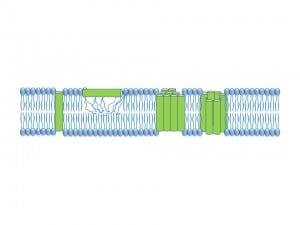Searching for new methods to kill bacteria
Kathleen Wang of the Camesano Lab has a new publication that describes the mechanism by which alimethicin, an antibiotic peptide that is produced naturally by the fungus Trichoderma viride, is able to penetrate cell membranes. Alimethicin kills bacteria by forming pores in their membranes. Kathleen performed experiments and mathematical modeling to tackle this complex problem. Along with collaborators from the Natick Soldier Research Development and Engineering Center, this work how provides detailed insight on how peptides can be used to kill bacteria.
The work is published in Colloids and Surfaces B: Biointerfaces, available at:
http://www.sciencedirect.com/science/article/pii/S092777651400037X.
Wang, K., Nagarajan, R., and T.A. Camesano. Antimicrobial peptide alamethicin insertion into lipid bilayer: A QCM-D exploration, Colloids and Surfaces B: Biointerfaces, 10.1016/j.colsurfb.2014.01.036

Green cylinders represent the antimicrobial peptide, alimethicin, inserting into a bacterial cell membrane. A supported lipid bilayer is used to represent the bacterial cell membrane (shown in blue).
